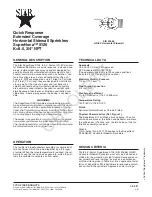
W
ITHOUT
C
OAX
*
W
ITH
C
OAX
29
(GB- '99)
*
M
ODY
*
E
RRE
P/R
*
P
ROJECT
*
P
UNTO
V
IRGOLA
*
S
LIM
The probability of breakdown in the video-
intercom systems is obviously greater than in
the intercom system. Consequently this brief
troubleshooting takes into consideration the
most common defects. When a defect is
limited to only one monitor it is evident that
the trouble is a short circuit to the monitor
itself, to the connecting terminal board or to
the wires that go to the riser. The simplest
way to test the efficiency of a monitor is to try
if in another flat where everything functions
correctly.
TROUBLESHOOTING
Preliminary checks
- Check for the presence of the mains voltage
between terminals 230 (or 127) and 0 of the
power supply.
- The power supply is not provided with fuses,
but all of its outputs are protected against
overloading and short circuiting by tempera-
ture sensors. To reset the power supply, pow-
er must be cut off for about one minute and
can be restored after having eliminated the
defect.
- Check the voltage output of the power
supply (see in detail the values indicated in
the power supply and control chapter).
- Check that the cross section of the wire
corresponds to what is indicated on page 26
and the descriptions of each diagram.
- Check that the connection of the wire corre-
sponds to the installation diagram.
Intercommunicating systems
During the intercommunication the door
speaker is activated.
The video system is ON (privacy towards the
outside only when the video system is in
stand-by). The module for intercommunicat-
ing has not been plugged in the timer art.1443.
Defective timer.
No audio in the intercommunicating serv-
ice.
The wall-brackets of the monitors have the J1
jumper in position of audio privacy (see pages
3, 5, 7, 9 and 10). Defective module for
intercommunicating. Defective timer.
The intercommunicating calls do not acti-
vate.
Check that the X1 and X2 wires are con-
nected correctly. Check that the J1 jumper is
in intercommunication position see pages 3,
5, 7, 9 and 10).
System with more entrances
Entrance A is never activated.
Short circuit between 5 and 6 of the ex-
changer. Defective exchanger.
Entrance B is never activated.
Short circuit between 3 and 4 of the ex-
changer. Defective exchanger. Absence of
power supply on 1 and 2 of the exchanger
(12Vac).
Audio section
No audio from either channel.
Absence of power supply voltage between 3
and 4 of the electronic door speaker (6÷8Vdc).
Short circuit between 3 and F of the timer. The
11 wire is interrupted. Defective timer.
No audio from the monitors to the door
station.
The 12 or 1 wire (from the timer to the door
station) is interrupted or has a short circuit.
Absence of the ground connection to terminal
4 of the electric door speaker. Defective door
speaker.
No audio from the door station to the
monitors.
The 13 or 2 wire (from the timer to the door
station) is interrupted or has a short circuit.
Defective door speaker.
Audio with humming in the background
(50/60 Hz).
The wires have been canalized together with
cables that power AC high absorption loads.
Separate the ground connection of the elec-
tric door speaker and of the name plate lights.
As visualized in the installation diagrams the
name plate lights must be powered from
terminals A and F of the power supply-timer
or when there are more than 8 lights from a
supplementary transformer (PRS 210). De-
fective power supply.
At the door station a whistle is heard
(Larsen effect).
The electric door speaker is badly housed in
the push-button panel (the microphone must
be stuck to the panel). Lower the volume.
Radio reception on the door station.
The defect can occur when there is a trans-
mitter working in the proximity. Apply a con-
denser from 0.1µF between terminals 1 and 3
of the electric door speaker.
Defects and probable trouble
Monitors shut OFF. Bells not functioning.
Control switching ON not functioning.
Absence of main voltage. Short circuits or
overloading of the output terminals of the
power supply and/or timer. Defective Power
supply. Defective timer.
Monitors shut OFF. Bells not functioning.
Control switch ON functioning.
The D wire is interrupted. Defective timer.
Monitors turn ON. Absence of image.
The H wire is interrupted. The coaxial cable is
interrupted or has a short circuit. The shield of
the coaxial cable is interrupted. The video
distributors (if present), are not being pow-
ered. Defective camera unit.
Control switch ON by monitors does not
function.
The 4 wire is interrupted. Defective timer.
The system does not shut OFF by replac-
ing the handset.
Such a defect can also be due to the non
working audio system from the door station to
the monitors (see related chapter). Defective
timer. Defective electronic speaker.
Unfocused image.
Adjust correctly the lens of the camera. De-
fective camera.
Image only slightly contrasted and/or out
of synchronism.
Coaxial cable loss or bad quality.
Coaxial cable not of 75
Ω
. High distance sys-
tem (use video amplifier art.476). Check the
correct connection of the coaxial cable (see
pages 26 and 27).
The electric door lock does not function.
Defective lock. The cross section of the wires
indicated in bold type is insufficient. A con-
necting wire to the lock has been interrupted.
The 9 wire is interrupted. Defective timer.
















































